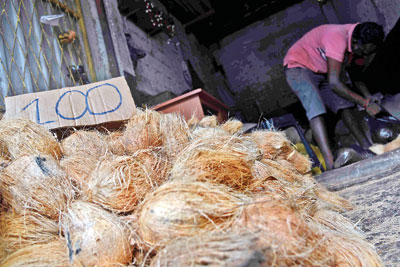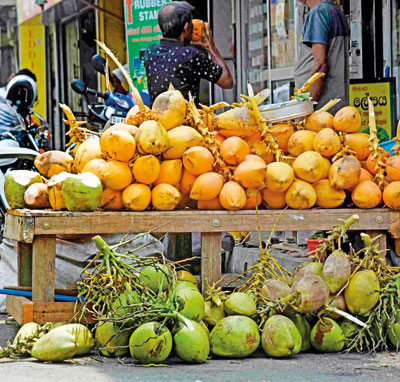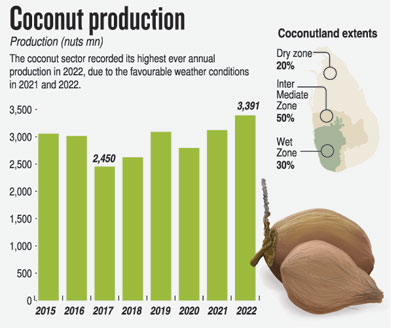News
Lack of inputs, policy bungling contribute to volatile price of coconuts and oil
View(s):By Nathara Abeywickrema
As most curries use coconut milk, the rapidly rising prices will have a significant impact on prepackaged rice and curry meals, consumer and civil rights activist Asela Sampath believes.
People will switch to alternatives or cook without coconut oil, he predicts. Non-communicable diseases could increase.
The coconut sector in Sri Lanka is experiencing a severe crisis as a result of several concerns, including ill-advised policy changes, fertiliser-related issues, high taxes, and a lack of government support.

Experts said production and productivity have dropped due in part to a loss of government subsidies as well as a labour shortage. Pix by Akila Jayawardena
Experts said production and productivity have dropped due in part to a loss of government subsidies as well as a labour shortage.
There is a shortage of nuts, and price increases are more often the result of a commodity’s scarcity than rising demand. The coconut industry is now exempt from government favouritism, receiving neither subsidies nor assistance for the smallholders who account for 69% of crop production.
Due to the drop in output, the price of coconuts and coconut oil may further rise in the upcoming months, which would cause a shift in cooking habits, consumer activists predict.
The country’s coconut land covers 30% of the wet zone, 50% of the intermediate zone, and 20% of the dry zone. The coconut sector recorded its highest ever annual production in 2022, due to the favourable weather in 2021 and 2022.
Household consumption accounts for 70% of overall production, with the remaining 30% going to industries.
The flower bud initiation in coconut inflorescence takes place in 32 months or 2.5 years. Within 12 months of the inflorescence opening, mature nuts occur, and it takes 42 months for the cycle to finish. The cultivator must wait two to three years to witness the effects of the inputs. The first three to four months following inflorescence opening are vulnerable to water scarcity.
Coconuts are typically gathered once every two months. Thus, each year there are six harvests, or six ‘pol mura’. The sixth ‘pol muraya’ contributes the least (10%) to the annual production, leading to a scarcity of nuts at the end of the year.
Peradeniya University’s crop science professor, L.K. Weerasinghe, said the impact of temperature is determined by the intensity, duration, and rate of temperature change. Usually in January–February, an extensive heat stress period is experienced, hence a very low fruit set is observed.
This reduction in fruit set can be attributed to reduced pollen germination under heat stress. Usually, female flower production is higher in May.
Since it takes 11–12 months to develop a nut from the inflorescence opening, November, December, January, and February produce a lower nut yield compared with other months. Usually, the highest nut yield is obtained in May, Prof. Weerasinghe explained.
For the coconut tree, which is climate-sensitive, to remain vigorous, sufficient care must be taken. 
A palm that yields 75–100 nuts a year will eliminate 740g of Nitrogen (N), 118g of Phosphorus (P), 1553g of potassium (K), and 143g of magnesium (Mg). So, 50–75 nuts per palm per year means that the nutrients N (424g), P (95g), K (1248g), and Mg (143g) will be extracted. Therefore, sustainable production requires the application of either organic or inorganic fertiliser to replenish lost nutrients, Prof. Weerasinghe said.
In coconut plantations, intercropping based on coconuts and mixed cropping systems are practical and profitable methods of managing weeds.
For growers, skilled and unskilled labour shortages and rising labour costs have become pressing concerns, Prof. Weerasinghe noted.
It has further been observed that tender coconuts (kurumba) are plucked before they mature. This means fewer coconuts and prices that range from Rs. 120 to Rs. 150. More tender coconuts are seen in the market than king coconuts.
Coconut Cultivation Board Chairperson Madhavi Herath said that coconut estates are at risk of forestation due to the lack of fertiliser for three years, as the coconut plant requires 2-3 years to produce high yields.
The CCB is in discussions with the National Fertiliser Secretariat and the government about distributing fertiliser at a fair price, Ms. Herath said.
Production in 2023 was 2,944 million nuts, a drop of 15% from the previous year, due to a number of factors, including dry spells in Kurunegala, Puttalam, and Gampaha.
The coconut sector in Sri Lanka has been significantly impacted by climate change. The effect of water scarcity is worsened by high temperatures, which interfere with pollination and cause button nut to fall and a few nuts per bunch.
The whitefly disease is another serious problem, especially in the Gampaha district, Ms. Herath noted.
The proper allocation of funding for the use of soap powder and neem oil, which are used to control the disease, has proven difficult.
“We encourage all coconut growers, regardless of acreage, to follow the best practices that CCB helps spread from the sapling stage to maturity of a coconut tree to raise yearly nut production to at least 3.6 to 3.8 billion by 2025,” Ms. Herath said.
Dr. Sanathanie Ranasinghe, the director of the Coconut Research Institute (CRI), said there is a great deal of demand from industry and the consumer due to the last six months’ production being less than the requirement.
Production will be lower from January to June, and prices could rise, but more production from July to August is anticipated.
According to Dr. Ranasinghe, the mismatch between supply and demand and the competitiveness between customers and the industry drive the price of nuts every day.
Dr. Ranasinghe highlighted ground-breaking initiatives to transform the coconut sector and increase coconut production, noting that the CRI had produced a number of novel hybrids that have the potential to greatly raise yields.
The CRI is increasing the seed production of the hybrids. Dr. Ranasinghe said that the whitefly disease is under control.
Sri Lanka’s coconut trade has advantages in international markets, said Prof. Roshan Perera, chairman of the Coconut Development Authority (CDA). “Our annual export volume is typically 25,000 containers, but this year we aim to increase that to 35,000 containers, generating a one billion rupee profit.’’
To meet the global demand for Sri Lankan coconut, it is imperative to tackle production obstacles, explore cutting-edge agricultural methods, and cooperate with specialists from other nations.
One big concern is that growers, manufacturers of coconut products, and consumers have to put up with price fluctuations.
Through collaborative efforts among industry participants, researchers, and policymakers, Sri Lanka may fully realise the potential of its coconut sector and maintain its standing as one of the world’s top exporters of coconut products.
Moreover, the CDA intends to seek cabinet clearance for the quality control procedure for imported coconut oil and standardise coconut prices in the local market through the CDA’s auction. The CDA further intends to propose digitalisation to bring all onto a single platform.
Meanwhile, Agriculture and Plantation Industries Minister Mahinda Amaraweera noted that maintaining a constant price for coconuts is not feasible.

The best way to say that you found the home of your dreams is by finding it on Hitad.lk. We have listings for apartments for sale or rent in Sri Lanka, no matter what locale you're looking for! Whether you live in Colombo, Galle, Kandy, Matara, Jaffna and more - we've got them all!

